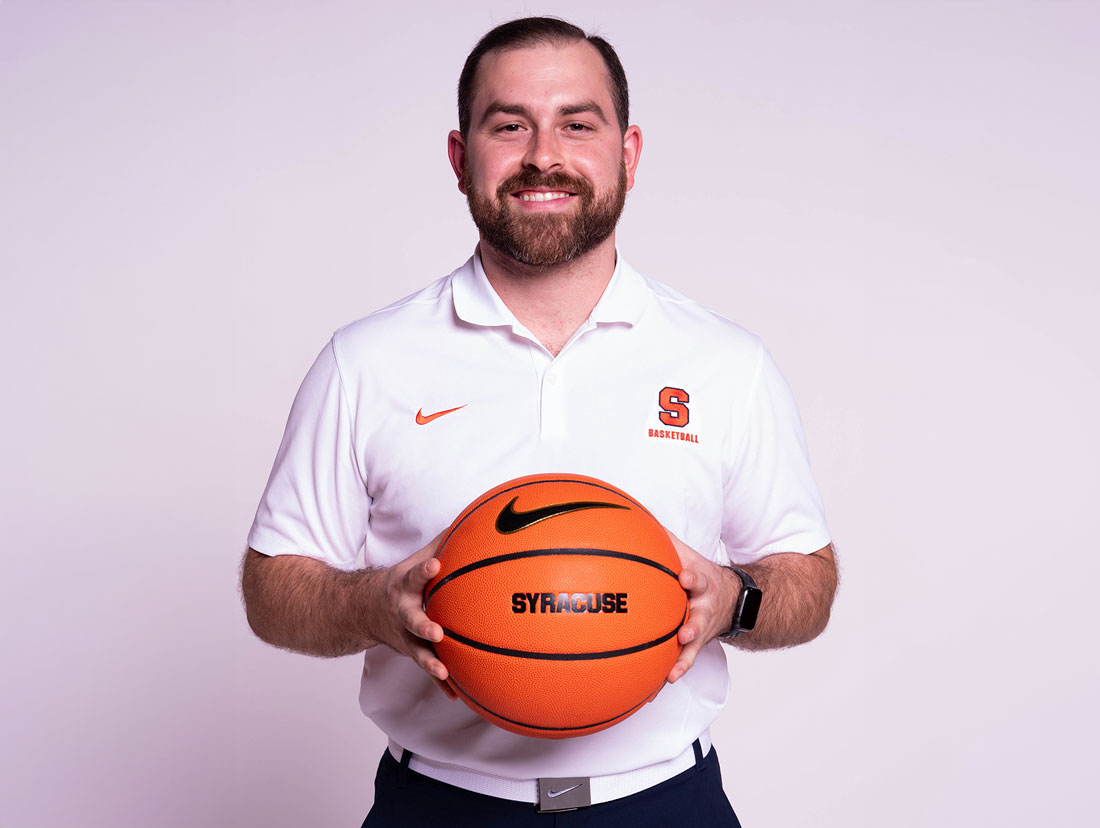
As the associate athletic trainer for the Syracuse University men’s basketball team, Mike Mangano says he’d much rather spend his time preventing injuries than treating them.
That’s why Mangano has fully embraced the partnership between the University’s Athletics Department and the Department of Sport Management in the Falk College of Sport and Human Dynamics that’s allowing nearly 50 students majoring in sport analytics to provide real-world data to assist the coaching and athletic performance staffs of 11 of Syracuse’s men’s and women’s athletic teams.
The specifics vary from sport to sport, but in general most students are collecting performance data from the student-athletes’ wearable devices; analyzing that data from training, practices, and games; and interpreting that data to provide insights to coaches and staff.
When Mangano was an assistant athletic trainer for the men’s soccer team, he says that kind of data helped coaches determine the optimum workload for each player. Once the players started maintaining that weekly goal, soft tissue injuries decreased.
“So, for me, it’s great. I don’t have to do as much work,” Mangano says, laughing. “But at the same time, my philosophy is, do the work on the front end. If you can prevent injuries–and obviously you can’t prevent them all–but if you can prevent most of the injuries and add that kind of education for the student-athletes and coaches, then (the analytics) are working for us.”
The genesis of this partnership between athletics and analytics can be traced to Mangano’s interest in analytics and sport performance and conversations he had with Francesco Riverso, the program manager for the Sport Analytics program and a former soccer standout at Le Moyne College in Syracuse. Riverso encouraged Mangano to earn his Certificate of Advanced Study in sport analytics, which Mangano did last year, and they arranged for sport analytics students to start collecting, analyzing, and interpreting data for the men’s soccer team in 2022.
Sport analytics students also started working with the women’s lacrosse team last season. The men’s soccer team won the 2022 Division I national championship, while the women’s lacrosse team reached the 2023 Division I Final Four.
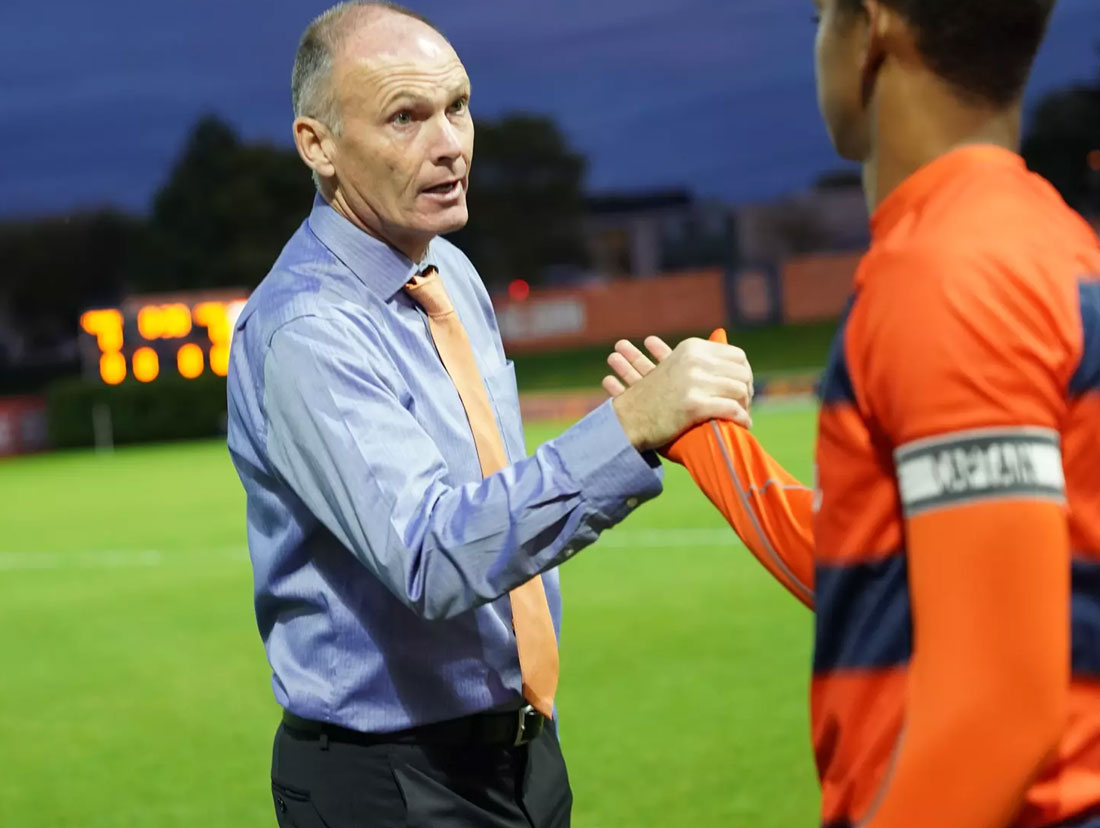
“The role of our student analysts has been integral to our program’s success,” says men’s soccer head coach Ian McIntyre. “The student analysts are responsible for collecting and interpreting all GPS data, and to provide detailed post-match and post-training reports. These reports are presented to the coaching staff with concise information that enables us to make objective decisions around training load and managing student-athletes’ minutes in games.
“In addition to the GPS data, the student analysts provide half-time and post-match reports of pre-determined categories that allow us to see how we are playing, and how we can make the necessary adjustments,” McIntyre adds.
The partnership expanded this academic year to include the following teams: women’s and men’s basketball, field hockey, football, ice hockey, women’s and men’s lacrosse, women’s and men’s soccer, softball, and track and field. Tommy Powell, assistant provost for student-athlete academic development at Syracuse, says the sport analytics students are available to all athletic teams and the athletic department plans to make this a long-term arrangement with the Sport Analytics program.
“This collaboration represents an exciting opportunity to merge the worlds of athletics and data analysis, further enhancing our ability to make informed decisions and drive success both on and off the field,” says Syracuse Director of Athletics John Wildhack. “Together, we will harness the power of analytics to gain a competitive edge and propel our student-athletes and teams to new heights.”
Rodney Paul, director of the Sport Analytics program and a professor in the Department of Sport Management, says the partnership provides sport analytics students with a one-of-a-kind opportunity to apply the data analytics skills they’re learning in class.
“It not only provides the students with real-world experience in sports but gives them the chance to see it applied directly to the University sports teams they already love and support,” Paul says.
There are currently 10 students working with the men’s basketball team, and Mangano says that group includes freshmen, sophomores, juniors, and seniors so they can “continue to keep that ladder going” in future seasons.
“For the students, they get real-life experience and can build their professional skills and resume by learning how to deliver that information to a real person,” Mangano says. “And it’s huge for us because, practically, we can’t pay 10 analytics people to come in and work us.”
To get a better understanding of this partnership, we talked to three sport analytics students about their roles with the Athletics Department. Here are their stories:
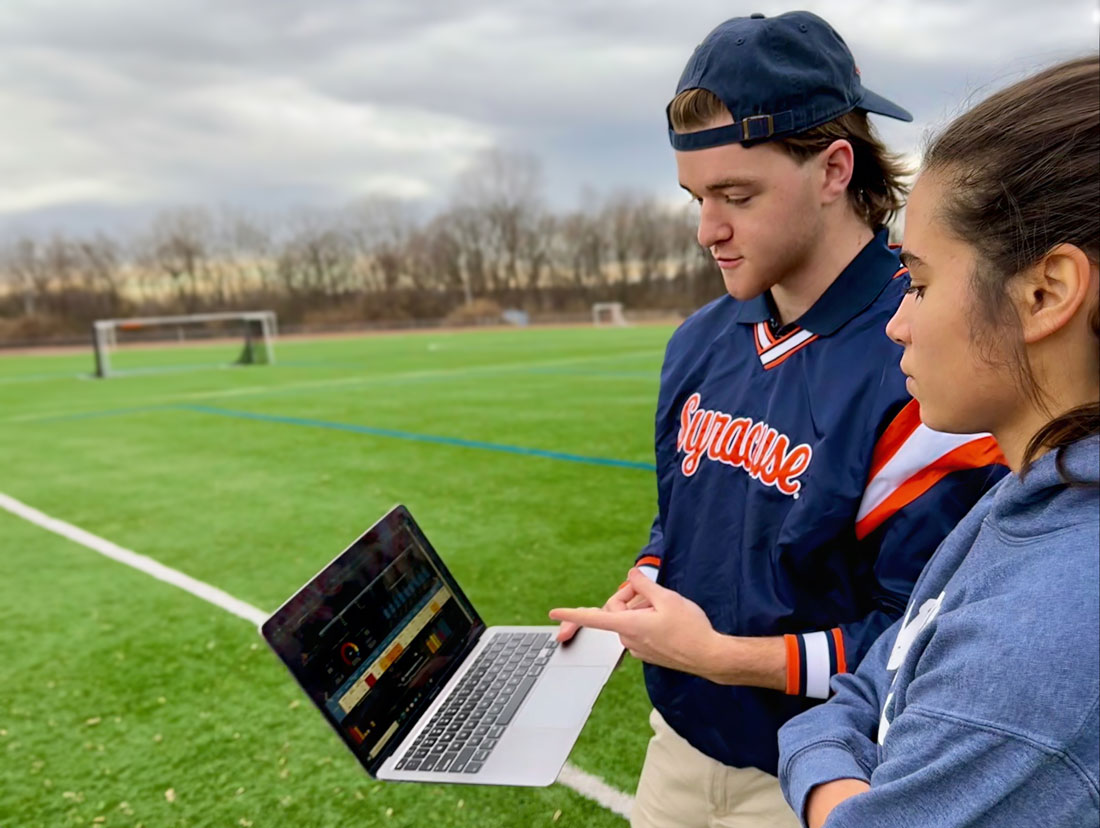
Dan Griffiths: Track and Field
Griffiths is a sophomore who was born in England and moved the United States with his family when he was 5. They moved again to Boston when he was 12, and in high school he participated in soccer and track and field (the decathlon and 400-meter dash were his two best events).
When he arrived at Syracuse University, he quickly learned that sport analytics majors are encouraged to apply for internships. With the partnership between athletics and analytics growing, and because of his love of track and field, Griffiths reached out to head coach Brien Bell to ask if he could work with the track and field and cross country teams. The teams hadn’t previously used a performance data analyst, and Bell welcomed Griffiths aboard and gave him the freedom to explore how to collect and analyze the data.
“My whole goal was to try to take their training data and make some predictions about how they can optimize their training to prevent injuries, make sure they’re not overtraining, and make sure they’re peaking at the optimal times at the end of the season for those big competitions,” Griffiths says.
When Griffiths started, the teams didn’t utilize a data-gathering system, but the track and field and cross country student-athletes were using Garmin wearables to track their own data. So, Griffiths built his own application and a tool that can transport all their data into his application, which then creates spreadsheets he can use to analyze that data.
“It’s not like an app you can download from the app store. It has an interface only I can see and it’s in partner with Garmin, the maker of the watches and owner of the data,” Griffiths says. “I was in contact with them for two weeks, figuring out how I can get connected and use their API (Application Programming Interface) and integrate that into my application.”
As an example of how he uses the data, Griffiths cited a female long-distance runner whose hardest training month based on heartrate was July, but as she built up her distance in the fall she was losing speed because her heartrate wasn’t at the optimum level. Based on the data Griffiths collected, she altered her training to reduce her miles but increase her heartrate, and that increased her speed and resulted in a personal best in late October.
“This is exactly why I came to Syracuse,” Griffiths says. “When I was on the tour (of campus), the tour guide said that sport analytics gets to work with some of the teams, and I thought the basketball team and the football team, and that’s going to be awesome.
“I didn’t really think I would be able to do it for the track team, and I didn’t see it as a possibility back then,” he continues. “But after my first year, I was very committed to being a part of the team and I saw that I could have this opportunity as long as I had the initiative to take it on myself.”
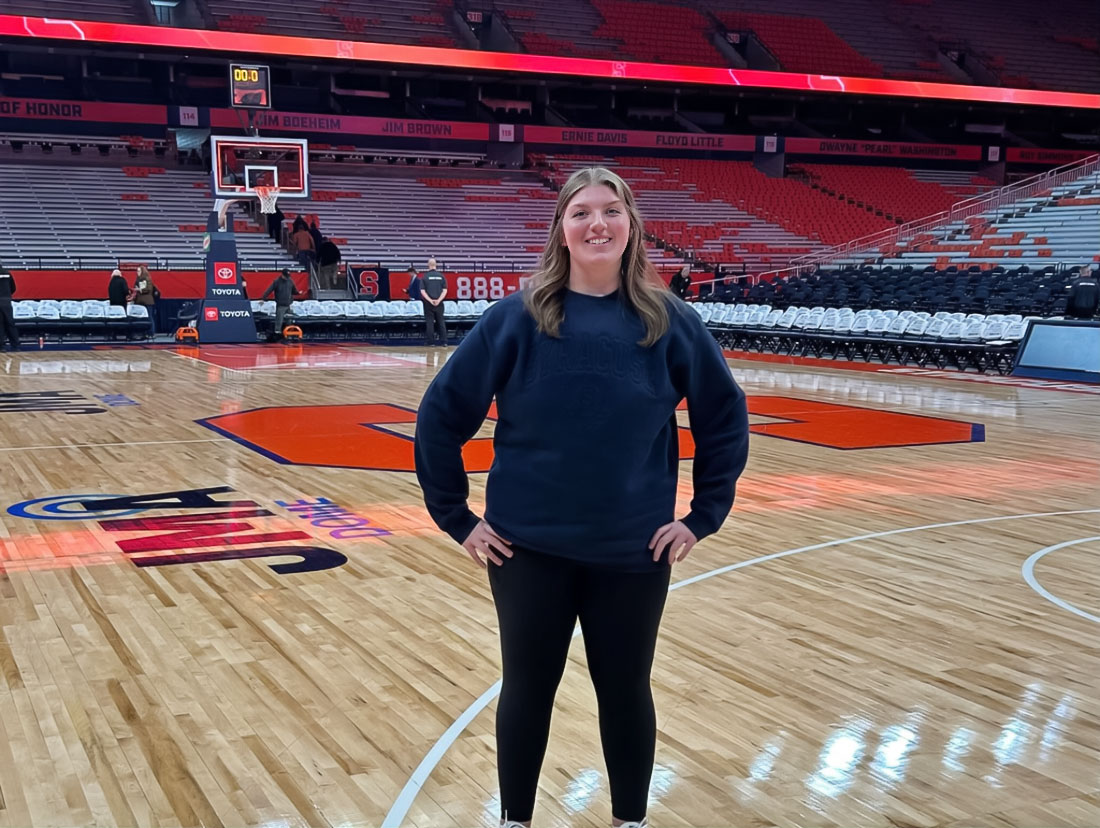
Danielle Napierski: Women’s Basketball
Napierski is a sophomore from Upper Saddle River, New Jersey, who’s a dual major in sport analytics and mathematics. As she was presented with this internship opportunity, Napierski had several reasons why she preferred the women’s basketball team.
“The coaches were open to having students who were passionate about working with this type of data metrics and analysis, and this was a perfect opportunity to start utilizing my knowledge and applying what I learned in the classroom,” she says. “This team is also a great community because the coaches are very flexible, appreciative, and open to anything that can help the team out.
“Lastly, I wanted to change the ratio of how men’s sports get the majority of the attention because these women work extremely hard to be where they are today and deserve recognition for their talent,” Napierski adds.
Napierski started working with the team in December 2022 with a sport analytics graduate student and they tracked the team’s number of passes per possession for each game. Over the summer, she had an internship in a collegiate baseball league and one of her co-interns was the current head manager for the women’s basketball team, senior sports analytics major Hayden Wasserman, who told Napierski that the team was looking to expand its analytics crew.
Once August rolled around and the team started practicing again, Wasserman reminded head coach Felisha Legette-Jack of Napierski’s interest in a career in sport analytics, and Legette-Jack invited Napierski to join this year’s team. To collect data, Napierski attends two or three practices a week, spends about five hours per week rewatching practices, and rotates with other managers at games collecting live statistics from Syracuse and its opponents.
“When the women are scrimmaging during practice, we create shot charts that we later put into (the computer program) RStudio and report back to the coaches so they can see how each individual is shooting from everywhere on the court,” Napierski says. “We do the same thing when we create scouting reports for our upcoming opponents, just so we can sense where each player likes to shoot and how efficient each player is.”
Napierski says her career goal is to work for an NBA or Major League Baseball team, or for either league. She grew up playing basketball, but switched to softball when she was older and enjoys working with both sports.
“Being a student manager for the (women’s basketball) team and working with data frequently will help me achieve my goal because any analytics position in any field looks for the same skillset in their applicants,” she says. “I have two more years of classes that will expand my knowledge of the industry, and this current position is the foundation of seeing how I can perform in this field and how I can grow for future full-time positions.”
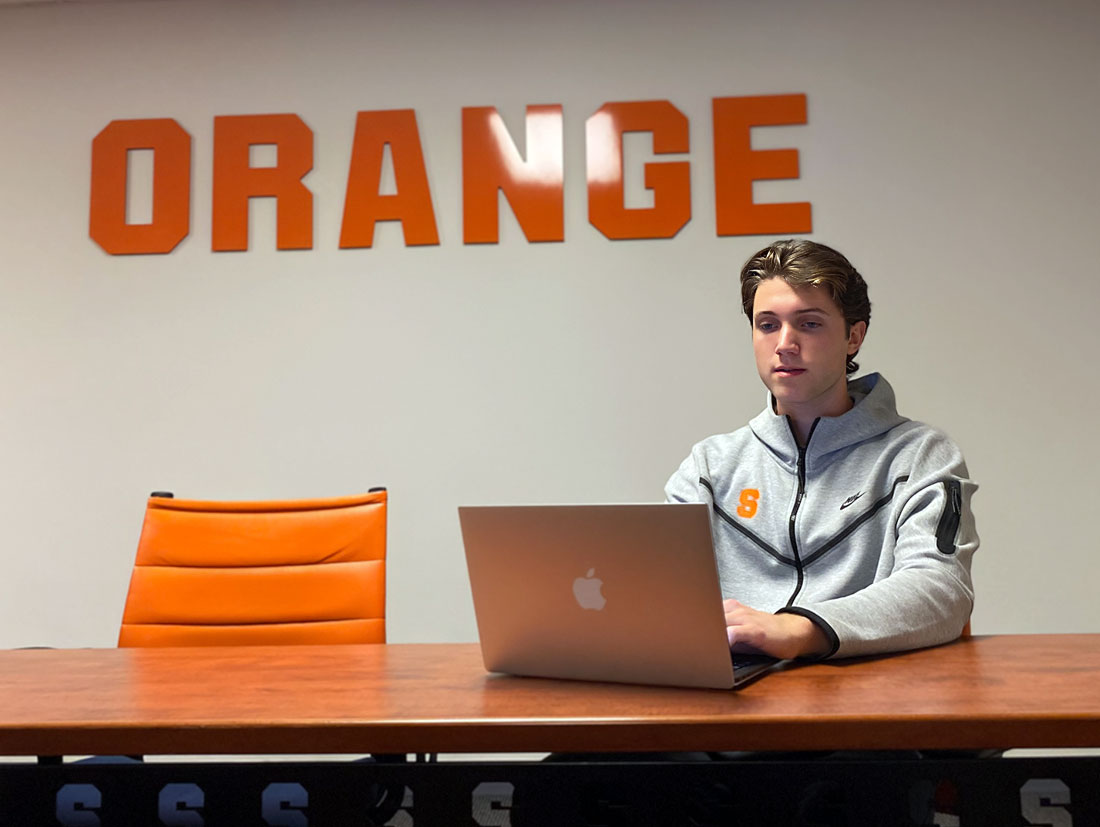
Caden Lippie: Women’s Lacrosse
A sophomore from Beverly, Massachusetts, Lippie has played soccer and ultimate frisbee in high school, and basketball in recreation leagues. Lacrosse wasn’t on his radar until Riverso sent out an email saying that the women’s lacrosse team was looking for sport analytics students to help analyze data from the student-athletes’ wearables.
That was last fall, and by late January Lippie was collecting and interpreting data, and by late May he was traveling with the team to the Final Four at the University of North Carolina. The team wanted to expand its use of training data because several players had suffered serious knee injuries in recent years and head coach Kayla Treanor was seeking information that might help inform their optimum workload.
“VX Sport is the wearable company, and they have units that the players wear for practices and games,” Lippie says. “Our role last year was to take those units and upload the data collected on them to a database on a computer and that data was sent to a representative from VX Sport who interprets that and goes over practice plans with the coaching staff.”
This year, Lippie will have an opportunity to expand his role as he’ll have access to practice and game footage and scouting reports and can explore using analytics in other ways to help the team.
“Incorporating sport analytics students into our women’s lacrosse program has been a game-changer, empowering us to make informed decisions and enhance our players’ performances,” Treanor says.
Lippie says he appreciates the flexibility that the team has provided, and the experience will be invaluable as he zeroes in on his career goals.
“What I appreciate most about this experience is that the (analytics) staff is relatively small compared to some of the other sports, so I’m able to do every aspect of analytics,” he says. “That’s the on-the-field analytics, the injury-prevention side, maybe less so with roster-building right now, but that could be an opportunity to explore with the team later. So, I’m able to look at all those different parts of analytics and hopefully decide what I like best and specialize in that. Or maybe incorporate all three.”
Syracuse University competes at the highest level of intercollegiate athletics, where the competition is fierce and winning is the bottom line. For both the teams that benefit from the analytics and the students who are doing the work, this partnership is truly a win-win.
“For us in athletics, it has helped build a bridge and expand our resources by utilizing their expertise,” Mangano says. “And for the students, the real-life experience doesn’t get any more real life than this.”
